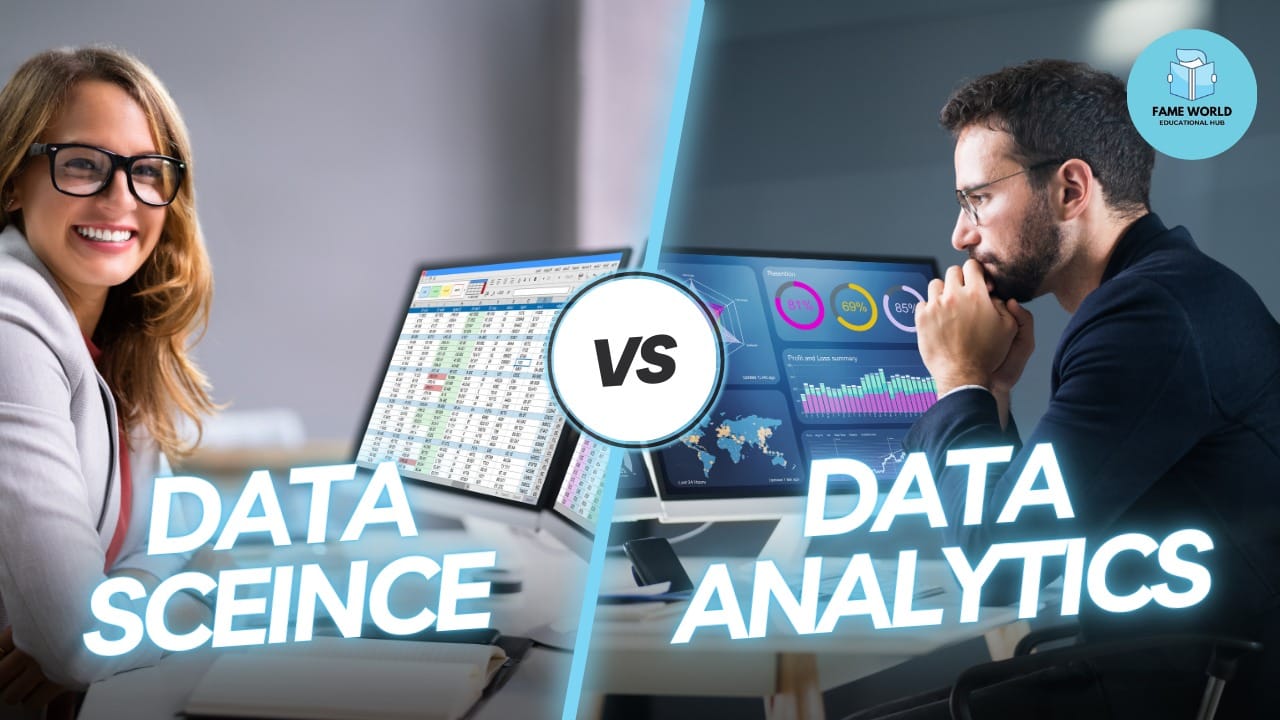In today’s data-driven world, Data Science and Data Analytics are two terms often used interchangeably. While they share similarities, they serve different purposes and require distinct skills. In this blog post, we’ll delve into the nuances of both fields, their unique roles, and how they complement each other. If you’re trying to decide which career path to pursue, this guide will help you make an informed choice.
Before diving in, be sure to check out this video for more information on Data Science vs. Data Analytics!
What is Data Science?
Data Science is a multidisciplinary field that combines statistics, computer science, and domain knowledge to extract insights and build predictive models. It focuses on uncovering trends and patterns from raw, unstructured data and often involves creating algorithms and using machine learning techniques.
Key Responsibilities of a Data Scientist:
- Data Collection and Cleaning: Gathering data from multiple sources and preparing it for analysis.
- Exploratory Data Analysis (EDA): Identifying trends, correlations, and anomalies in the data.
- Model Building: Using machine learning algorithms to build predictive and prescriptive models.
- Visualization and Communication: Presenting complex results in an understandable way.
- Innovation: Developing new tools and methods for analyzing large datasets.
Tools and Technologies:
- Programming: Python, R, SQL
- Machine Learning: TensorFlow, Scikit-learn
- Big Data: Hadoop, Spark
- Data Visualization: Tableau, Matplotlib
Real-Life Applications of Data Science:
- Predicting customer behavior in e-commerce.
- Detecting fraudulent transactions in banking.
- Enhancing medical diagnoses through AI-powered tools.
What is Data Analytics?
Data Analytics is the process of analyzing structured data to generate actionable insights. It is more focused on answering specific business questions and improving decision-making rather than building predictive models.
Key Responsibilities of a Data Analyst:
- Data Querying: Extracting specific datasets using SQL or similar tools.
- Data Cleaning and Preparation: Ensuring the data is accurate and ready for analysis.
- Analysis: Using statistical techniques to interpret data.
- Reporting: Creating dashboards and reports to communicate findings.
- Optimization: Identifying ways to improve business processes.
Tools and Technologies:
- Spreadsheets: Microsoft Excel, Google Sheets
- Business Intelligence: Power BI, Tableau
- Programming: Python, SQL
- Statistical Tools: SAS, SPSS
Real-Life Applications of Data Analytics:
- Monitoring sales trends and inventory in retail.
- Analyzing website traffic for digital marketing strategies.
- Tracking employee performance metrics in HR.
Key Differences Between Data Science and Data Analytics
| Aspect | Data Science | Data Analytics |
| Focus | Unstructured data and predictive modeling | Structured data and business insights |
| Objective | Building algorithms and models for predictions | Answering specific questions to guide decisions |
| Skillset | Machine learning, programming, statistics | Querying, reporting, and statistical analysis |
| Outcome | Future-oriented insights | Present-oriented insights |
Career Path Comparison
Data Science:
- Best for: Those interested in research, AI, and predictive analytics.
- Popular Roles: Data Scientist, Machine Learning Engineer, AI Specialist.
- Average Salary: $120,000/year (varies by region).
Data Analytics:
- Best for: Individuals who enjoy working with structured data and creating actionable reports.
- Popular Roles: Data Analyst, Business Analyst, BI Developer.
- Average Salary: $70,000/year (varies by region).
How Do They Complement Each Other?
Though distinct, Data Science and Data Analytics often overlap. Data Analysts prepare the data that Data Scientists use for modeling. Similarly, insights from Data Science can guide analysts in refining their metrics. Together, they form a cohesive data strategy for organizations.
How to Choose Between Data Science and Data Analytics?
- Evaluate Your Interests: If you love coding and algorithms, go for Data Science. If you enjoy uncovering insights and presenting them, Data Analytics is for you.
- Learn the Skills: Both fields require some level of proficiency in Python, SQL, and data visualization.
- Try Projects: Explore real-world projects in each field to see what excites you the most.
- Consider Your Career Goals: Decide whether you want to focus on research and innovation or business-driven analysis.
Conclusion
Whether you choose Data Science or Data Analytics, both fields offer exciting opportunities in the data-driven economy. They require distinct skills but often overlap in their applications. Understanding your interests and career goals can help you pick the right path.
For a deeper dive into this topic, don’t forget to watch this video for more insights. Let us know in the comments which field excites you the most!
Stay Connected:
If you enjoyed this post, subscribe for more updates on data careers, tools, and trends!
Additional learning resources:
PYTHON Q&A SERIES – Link
IOT TUTORIAL SERIES – Link
PYTHON PROGRAMMING TUTORIAL SERIES – Link
CAREER TIPS – Link
CLOUD COMPUTING – Link
MERN FULL STACK WEB DEVELOPMENT – Link
DJANGO SERIES – Link
DIGITAL MARKETING – Link
C LANGUAGE – Link
CODING INTERVIEW PREPRATION – Link
NEW AI TOOLS – Link
PYTHONISTA FOR PYTHON LOVERS – Link
ARTIFICIAL INTELLIGENCE – Link
MACHINE LEARNING USING PYTHON – Link
DBMS – Link
PYTHON PROGRAMMING QUIZ SERIES – Link
BLOCKCHAIN TECHNOLOGY TUTORIAL SERIES – Link
NETWORKING QUIZ SERIES – Link
CYBER SECURITY Q&A SERIES – Link
PROGRAMMING RELATED STUFF – Link



